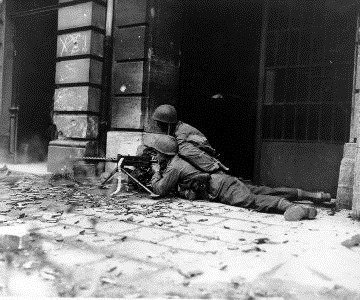Task Force Bacon 15-22 November

Task Force Bacon (1/379th, 2/378th and 1/377th) began its operation on 15 November, timed to coincide with the parallel attack by the 377th and 378th west of the river. Since the fight to free the 1/377th in the Bertrange sector consumed most of the day, the drive south did not begin until the next morning. The advance was made in two columns, moving along parallel roads on a narrow front, with tank destroyers and tanks – later reinforced by two self-propelled 155mm guns – at the head of each column and wit the infantry following in trucks and on foot. The fire power in front blasted enemy strong points along the road. Then the infantry stepped in to mop up, or launch an assault, according to the degree of stubbornness shown by the German grenadiers and gunners after they had been subjected to concerted tank and tank destroyer fire. When the terrain and the enemy combined to slow down one column, the second column hooked around the position into the German flank and rear.
On 16 November, TF Bacon made an advance of four and a half miles at the expense of the 1216th Regiment, whose connection with the 19th VG Division on the right now had been broken. The TF continued south on 17 November pushing its self-propelled guns forward to engage defended road blocks and bunkers at ranges as short as two hundred yards. At dark the task force columns merged along the main river road within sight of Fort St. Julien, less than 4000 yards from the center of Metz. The CO decided to send the 2/378th against For St. Julien, whose strength and controlling position on the main highway made an assault imperative. At the same time he planned to switch the 1/377th around past the fort in an attempt to keep the advance moving.
The battle for Fort St. Julien, conducted by the infantry supported by 155mm, 240mm artillery, tanks and tank destroyers, combined with demolition experts from the engineers lasted all day on 18 November. Resistance did not end until a 155mm gun was run up in close quarters to bombard the fort. The next day 200 docile prisoners were taken out of the network of tunnels below the fort.
While its sister battalion was fighting its way toward Fort St. Julien on 18 November, the 1/377th had bypassed to the west and marched through the suburbs of St. Julien-le-Metz. Barring the northeastern entrance to the older portion of Metz lay another large but outmoded work, Fort Bellecroix. Just as the battalion started forward to form for the assault a column of about 100 hundred German infantry came hurrying out of the fort with white flags in their hands. The reason for this hasty evacuation soon became evident. About 1400, as the battalion was moving along the street by the fort, two terrific blasts shattered the heavy masonry walls bringing the debris down on the startled Americans and leaving 57 dead and wounded in C Company, which at the moment was closest to the fort. The rest of the battalion threaded its way through the rubble. As the day ended patrols form the task force began to mop up the scattered centers of resistance at the northern edge of the city. TF Bacon continued to take part in the rather desultory street fighting of the next few days and was dissolved on 22 November when resistance in Metz officially ended.







